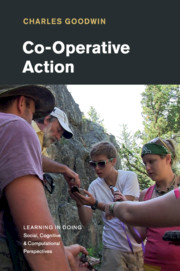Book contents
- Co-Operative Action
- Learning in Doing: Social, Cognitive and Computational Perspectives
- Co-Operative Action
- Copyright page
- Dedication
- Contents
- Figures
- Acknowledgments
- 1 What Is Co-Operative Action, and Why Is It Important?
- Part I Co-Operative Accumulative Action
- 2 Co-Operative Accumulation as a Pervasive Feature of the Organization of Action
- 3 The Co-Operative Organization of Emerging Action
- 4 Chil and His Resources
- 5 Building Complex Meaning and Action with a Three-Word Vocabulary
- 6 The Distributed Speaker
- Part II Intertwined Semiosis
- Part III Embodied Interaction
- Part IV Co-Operative Action with Predecessors
- Part V Professional Vision, Transforming Sensory Experience into Types, and the Creation of Competent Inhabitants
- References Cited
- Index
- Series page
5 - Building Complex Meaning and Action with a Three-Word Vocabulary
Inhabiting and Reshaping the Actions of Others through Accumulative Transformation
from Part I - Co-Operative Accumulative Action
Published online by Cambridge University Press: 03 November 2017
- Co-Operative Action
- Learning in Doing: Social, Cognitive and Computational Perspectives
- Co-Operative Action
- Copyright page
- Dedication
- Contents
- Figures
- Acknowledgments
- 1 What Is Co-Operative Action, and Why Is It Important?
- Part I Co-Operative Accumulative Action
- 2 Co-Operative Accumulation as a Pervasive Feature of the Organization of Action
- 3 The Co-Operative Organization of Emerging Action
- 4 Chil and His Resources
- 5 Building Complex Meaning and Action with a Three-Word Vocabulary
- 6 The Distributed Speaker
- Part II Intertwined Semiosis
- Part III Embodied Interaction
- Part IV Co-Operative Action with Predecessors
- Part V Professional Vision, Transforming Sensory Experience into Types, and the Creation of Competent Inhabitants
- References Cited
- Index
- Series page
Summary
By using “No No. No:.” to object strongly to something another speaker has just said, Chil is able to construct an utterance that performs two very consequential operations on the talk of the prior speaker: 1) despite his impoverished lexicon his utterance indexically incorporates her rich language structure; he is not heard to say No, as an isolated self-contained unit, but instead to be including what she said within the scope of his objection. 2) The symbolic power of No as a conventionalized sign transforms the proposition inherited co-operatively from the prior speaker by negating it. Indexical incorporation constitutes a powerful supplement to the accumulative practices of decomposition and reuse examined in earlier chapters. Chil’s symbols, though very limited, enable him simultaneously to transform what is being incorporated. Peirce’s model of the sign, which encompasses both indexical and symbolic practices, is used to diagram this process. Insofar as each next sign incorporates what it is operating upon, chains of accumulative transformations occur. Chil becomes a powerful speaker, able to produce complex propositions, by co-operatively incorporating with transformation into his own actions rich language structure created by others.
* * *
- Type
- Chapter
- Information
- Co-Operative Action , pp. 68 - 79Publisher: Cambridge University PressPrint publication year: 2017

